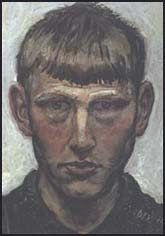Otto Dix.

This is coolbert:
"He'd actually had [served] three years nearly at the front, as a gunner, in very heavy firing [fighting] consistently in France, Flanders, and Russia."
"But we know from other people's statements that this bloke [Dix] would sit in the trench just before and after grenades were biffing around the place and actually drawing." - - Sarah O'Brian-Twohig - - Tate Gallery.
"biff tr.v. biffed, biff·ing, biffs
To strike or punch. n. A blow or punch."
This bloke - - is Otto Dix. One of the foremost artists of the 20th Century?
German soldier and artist. Saw extensive combat during World War One [WW1]. Also served as a member of the German volkssturm during World War Two [WW2]. Captured by the French in 1945 and held prisoner until 1946.
[he was fifty four years old in 1945.]
Did not wait to be drafted in 1914. Was a volunteer. By his own words:
"The war was a horrible thing, but there was something tremendous about it too. I didn't want to miss it at any price. You have to have seen human beings in this unleashed state to know what human nature is... I need to experience all the depths of life for myself, that's why I go out, and that's why I volunteered." - - O. Dix.
"Carried copy of Nietzsche, The Joyous Science and the Bible in his soldier's knapsack. From N [Nietzsche] Dix learned that growth and decay necessary part of nature, procreation and death part of the life cycle, struggle for survival, cruel cycle of birth and death."
Most creative period was post-WW1. Drew and painted somewhat in the manner of the Dada movement, but was NOT a dadaist as such! Did share [with the dadaists] a similar world-view and outlook on the nature of war as it existed following the armistice of 1918.
Through his art [as with the dadaists] expressed a revulsion with the industrialized, mechanized, mass-production, assembly line, by-the numbers, totally impersonal warfare as exemplified by WW1. You are very small cog in a big wheel that is part of much larger machine, raw product [recruit] in one end of the line, finished good [soldier] out the other, shortly discarded [killed] when used in an abusive and callous manner by the "powers" .

Otto Dix "Machine Gunners Advancing" from Der Krieg (1924).
[please look closely at the detail of "Machine Gunners Advancing". The machine gun unit is advancing over A MOUNTAIN OF HUMAN BODIES!!
And here is how Dix portrays that very violent form of battle from World War One [WW1], the trench raid.

Dix was also very fond of self-portraits.

Dix as a machine gunner during the Great War [WW1].

Dix as a prisoner-of-war in 1946.
Dix had critics [the Nazi regime of Hitler among them], such as the gadfly art "critic" Julius Meier-Graefe.
"Meier-Graefe reviewed [ing] Otto Dix's painting, The Trench, in July, 1924."
"The trench is not only badly, but disgracefully painted, with a penetrating delight in detail, not I hasten to add, in sensuous detail but in matter-of-fact detail. Brains, blood and entrails can be painted in a way which makes one's mouth water. This Dix - forgive the crude expression - makes you want to throw up."
THAT IS THE WHOLE IDEA - - JULIUS. The idea of "The Trench" is to revolt you and make you want to throw up. That is what Dix intended.
coolbert.
Labels: Dix

0 Comments:
Post a Comment
Subscribe to Post Comments [Atom]
<< Home